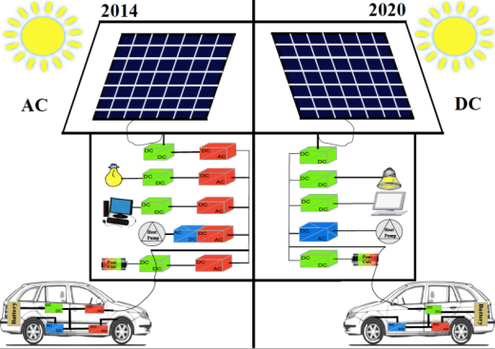Distribution technologies for smart buildings

Project description
The main goal of this project is to increase the efficiency of the electrical infrastructure in houses and buildings through an intelligent and more flexible participation of decentralized generation, storage and controllable loads, as well as through the optimization of the power conversion steps (AC to DC, DC to AC, etc).
The higher participation of decentralized generation and storage devices working on DC, like photovoltaic cells, fuel cells, batteries, electric vehicles, etc, brings new opportunities for the built environment. Connecting DC sources and storage via a DC networks brings lower investment costs and higher efficiency. This can be attained for example by savings in copper: the same cable can carry from 50% to 100% more DC power than AC power. In terms of efficiency, a higher efficiency of energy transfer can be achieved by removing one conversion step. Moreover, a DC-DC conversion has higher efficiency than an AC-DC conversion by 2-3 % and is less costly.
Our research will propose solutions for DC low-voltage distribution infrastructures that include storage in terms of (1) optimized conversion steps, (2) optimized distribution topologies, (3) a power and energy management system that will optimize the use of storage and renewable energy. In this way, we will facilitate the introduction of efficient low-voltage DC networks for smart buildings. The possibility of having a hybrid network containing AC and DC segments will be also investigated.
First, different distribution topologies and conversion steps will be evaluated by means of detailed simulations for a low-voltage DC network containing high participation of DC generation and storage. In this way, it will be possible to determine if the complete network should operate in DC or if a hybrid topology is more suitable. Secondly, different types of sources and storage will be analyzed and respectively accommodated in selected distribution topology. Attention will be given to the cost and savings of the infrastructure too. Short circuit behaviour of distribution topologies will be identified too. Thirdly, based on the research, design rules for decentralized generation and storage (sizing and layout), an intelligent power and energy management system will be developed. This power and energy management system will enable the users to consume the energy that is locally produced in house/building by making an optimized use of storage.